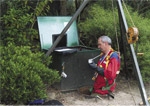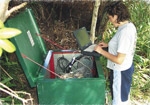Contaminants in urban stormwater: how much from where?



In the past, stormwater treatment was mostly focused on controlling sediment. Over the last 10 years or so, however, there’s been rapidly growing recognition that chemical contaminants in urban stormwater can severely degrade the quality of urban freshwater and coastal marine ecosystems.
NIWA recently completed an intensive quality and discharge monitoring programme for Auckland City Council and Metrowater. We recorded the discharge at sites in the stormwater network of eight catchments, and collected and analysed more than 1000 stormwater quality samples.
A model which we originally developed as part of NIWA’s urban contaminants research programme, funded by the Foundation for Research, Science & Technology, for predicting chemical contaminant loads in road run-off has now been adapted to predict urban stormwater quality. The model incorporates the processes of contaminant accumulation and wash-off (which depends on the intensity of stormwater run-off). It is designed to work in conjunction with other models already operated by many local authorities for predicting stormwater flows from outfalls. We used the data collected in the Auckland City Council/Metrowater monitoring to calibrate the model for zinc, copper, and lead in stormwater from residential, commercial, and industrial land uses.
The model produces time series at 5 minute intervals of contaminant loads for specific stormwater outfalls. This information can be put directly into hydrodynamic dispersion models to predict the fate of the contaminants in estuaries and harbours. Alternatively, the time series can be used to calculate total contaminant loads over selected intervals of time.
